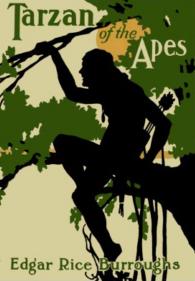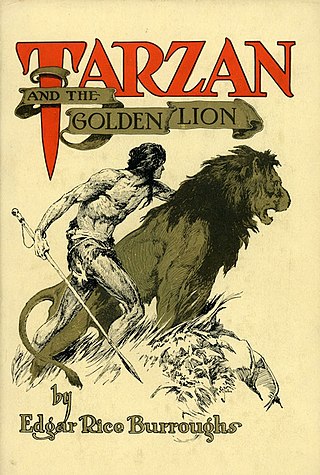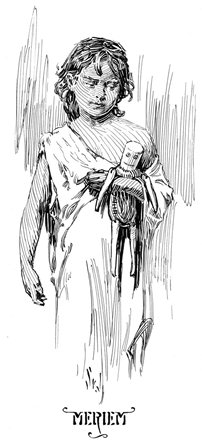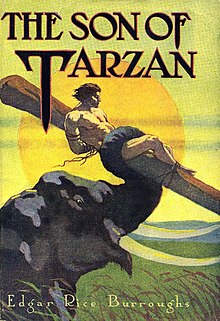
Russell George Manning was an American comic book artist who created the series Magnus, Robot Fighter and illustrated such newspaper comic strips as Tarzan and Star Wars. He was inducted into the Will Eisner Award Hall of Fame in 2006.

Tarzan of the Apes is a 1912 novel by American writer Edgar Rice Burroughs, and the first in the Tarzan series. The story was first printed in the pulp magazine The All-Story in October 1912 before being released as a novel in June 1914.

Korak, a fictional character, is the ape name of John "Jack" Clayton III, the son of Tarzan and Jane Porter.

Tarzan the Untamed is a book by American writer Edgar Rice Burroughs, the seventh in his series of twenty-four books about the title character Tarzan. It was originally published as two separate stories serialized in different pulp magazines; "Tarzan the Untamed" in Redbook from March to August, 1919, and "Tarzan and the Valley of Luna" in All-Story Weekly from March to April 1920. The two stories were combined under the title of the first in the first book edition, published in 1920 by A. C. McClurg. In order of writing, the book follows Jungle Tales of Tarzan, a collection of short stories about the ape-man's youth. Chronologically, it follows Tarzan and the Jewels of Opar.

The Return of Tarzan is a novel by American writer Edgar Rice Burroughs, the second in his series of twenty-four books about the title character Tarzan. The story was first published in the pulp magazine New Story Magazine in the issues for June through December 1913; the first book edition was published in 1915 by A. C. McClurg.

Tarzan and the Ant Men is a novel by American writer Edgar Rice Burroughs, the tenth in his series of twenty-four books about the jungle hero Tarzan. It was first published as a seven-part serial in the magazine Argosy All-Story Weekly for February 2, 9, 16 and 23 and March 1, 8 and 15, 1924. The story was first published in book form in hardcover by A. C. McClurg in September 1924. It was also adapted for Gold Key Comics in Tarzan #174-175 (1968).

The Beasts of Tarzan is a novel by American writer Edgar Rice Burroughs, the third in his series of twenty-four books about the title character Tarzan. Originally serialized in All-Story Cavalier magazine in 1914, the novel was first published in book form by A. C. McClurg in 1916.

Tarzan and the Jewels of Opar is a novel by American writer Edgar Rice Burroughs, the fifth in his series of twenty-four books about the title character Tarzan. The story first appeared in the November and December issues of All-Story Cavalier Weekly in 1916, and the first book publication was by McClurg in 1918.

Jungle Tales of Tarzan is a collection of twelve loosely connected short stories by American writer Edgar Rice Burroughs, comprising the sixth book in order of publication in his series of twenty-four books about the title character Tarzan. Chronologically the events recounted in it occur within Chapter 11 of the first Tarzan novel, Tarzan of the Apes, between Tarzan's avenging of his ape foster mother's death and his becoming leader of his ape tribe. The stories ran monthly in Blue Book magazine, September 1916 through August 1917 before book publication in 1919.

Tarzan the Terrible is a novel by American writer Edgar Rice Burroughs, the eighth in his series of twenty-four books about the title character Tarzan. The story was first published as a serial in the pulp magazine Argosy All-Story Weekly in the issues for February 12, 19, and 26 and March 5, 12, 19, and 26, 1921; the first book edition was published in June 1921 by A. C. McClurg. Its setting, Pal-ul-don, is one of the more thoroughly realized "lost civilizations" in Burroughs' Tarzan stories. The novel contains a map of the place as well as a glossary of its inhabitants' language.

Tarzan and the Golden Lion is an adventure novel by American writer Edgar Rice Burroughs, the ninth in his series of twenty-four books about the title character Tarzan. The story was first published as a seven part serial in Argosy All-Story Weekly beginning in December 1922; and then as a complete novel by A.C. McClurg & Co. on March 24, 1923.

Tarzan, Lord of the Jungle is a novel by American writer Edgar Rice Burroughs, generally considered the eleventh in his series of twenty-four books about the title character Tarzan. The story was first published as a serial in Blue Book Magazine from December 1927 through May 1928; it first appeared in book form in a hardcover edition from A. C. McClurg in September 1928.

Tarzan and the City of Gold is a novel by American writer Edgar Rice Burroughs, the sixteenth in his series of twenty-four books about the title character Tarzan. The novel was originally serialized in the magazine Argosy from March through April 1932.

Tarzan and the Lion Man is a novel by American writer Edgar Rice Burroughs, the seventeenth in his series of twenty-four books about the title character Tarzan. The novel was originally serialized in the magazine Liberty from November 1933 through January 1934.

Tarzan and the Foreign Legion is a novel by American writer Edgar Rice Burroughs, the twenty-second in his series of twenty-four books about the title character Tarzan. The book, written June–September 1944 while Burroughs was living in Honolulu and published in 1947, was the last new work by Burroughs to be published during his life. The novel is set during World War II in Sumatra, Dutch East Indies. The term "foreign legion" does not refer to the French Foreign Legion, but is the name given in the book to a small international force fighting the Empire of Japan.

Tarzan, a fictional character created by Edgar Rice Burroughs, first appeared in the 1912 novel Tarzan of the Apes, and then in 23 sequels. The character proved immensely popular and quickly made the jump to other media, including comics.

Meriem is a character in Edgar Rice Burroughs's series of Tarzan novels, and the heroine of the fourth, The Son of Tarzan.

The Son of Tarzan is a 1920 15-chapter American film serial which focuses on the coming of age of Jack Clayton, also known as Korak, the son of Tarzan and Jane. The serial was produced by David P. Howells, written by Roy Somerville, and directed by Arthur J. Flaven and Harry Revier. The film was released starting in the summer of 1920, with the final chapter released in January 1921.

Tarzan is a fictional character, a feral child raised in the African jungle by the Mangani great apes; he later experiences civilization, only to reject it and return to the wild as a heroic adventurer.

Tarzan is a series of 24 adventure novels written by Edgar Rice Burroughs (1875–1950) and published between 1912 and 1966, followed by several novels either co-written by Burroughs, or officially authorized by his estate. There are also two works written by Burroughs especially for children that are not considered part of the main series.



















